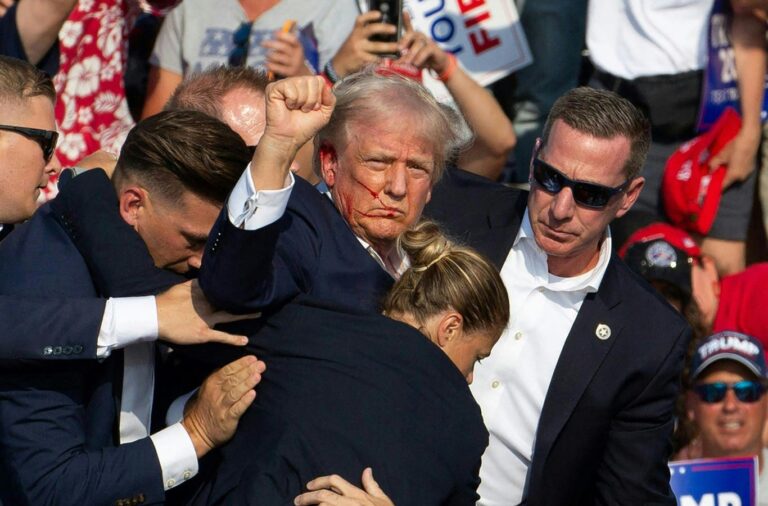Conspiracy theories abound regarding the attempted assassination of the former president. … [+]
This month has been a big one for American politics, with the assassination attempt on former President Donald Trump, President Joe Biden’s withdrawal after pledging to continue the race for weeks, Trump’s selection of Ohio Senator J.D. Vance as his running mate, and the Democratic Party’s endorsement of Vice President Kamala Harris. In the wake of this, political commentators have been busy offering their views on the 2024 presidential election.
But social media is awash with conspiracy theories mixed with an unhealthy dose of misinformation and blatant disinformation, including the equally outlandish notion that Trump’s assassination was a meticulously orchestrated “false flag” operation to garner voter support, and counter-arguments that Biden ordered it or that the Secret Service authorized the shooter. Similarly, there’s talk that Biden is not just politically dead but dead after his poor performance in last month’s debate, and that Vance was “romantically involved” with Soffer.
Conspiracy theories have always been around, but it’s almost hard to believe they could have thrived so much in the pre-social media era, and social media platforms seem designed to spread such misinformation and disinformation.
“Social media platforms are designed to maximise user engagement. Algorithms prioritise content that evokes strong emotional responses such as fear, anger or surprise. Conspiracy theories, by their very nature, often incite these emotions, making them more likely to be promoted by algorithms attempting to keep users engaged,” explained Sophia Wakabayashi, CEO of social media strategy and branding firm Waka Growth.
It’s impossible to thoroughly verify each news story at an early stage, which allows misinformation to spread before it can be thoroughly fact-checked. At the same time, most media algorithms are designed to increase adversarial exchanges and echo chambers, because conflict increases the level of engagement and truth naturally becomes a casualty, warned Irina Zukerman, president and geopolitical analyst at Scarab Rising.
“Social media companies are not optimized for the most accurate information, but at best for the most ‘democratic’ conversational environment and, in most cases, for the type of content that best suits the agenda of the various stakeholders involved in the regulatory process – from executives to content moderators – who are at best undertrained, overworked, and vulnerable to social engineering and deception by outside forces,” Zuckerman continued.
The echo chamber gets bigger
A key factor is that social media has become an echo chamber where users curate their news feeds and follow like-minded individuals, allowing misinformation and conspiracy theories to spread without critical scrutiny. This is coupled with a growing distrust of traditional media among many people.
“Such selective exposure reinforces existing beliefs and makes it easier for misinformation to spread,” Wakabayashi added. “The rapid sharing and spreading potential of social media means that sensational content, including conspiracy theories, can spread quickly and far and wide. The ease of sharing and broad reach of these platforms can amplify misinformation on an unprecedented scale.”
Digital defamation
Many of the people who posted claims that Trump faked the assassination attempt or details about the Vance couch incident may not believe the stories, but they expect others to — and that the disinformation is simply intended to sway the election — have taken the win-at-all-costs mentality to new and potentially dangerous extremes.
Americans should not hope that lies about any candidate will change the outcome of the election, especially since if this does affect the outcome of the election, it will only make things worse.
“We expect to see a surge in disinformation surrounding the election. Unfortunately, this is a persistent problem, but it will fluctuate. The impact of disinformation campaigns after the election will be less than before the election. We may see a surge later in the year. We’ve already seen some,” warned Lou Steinberg, founder and managing partner at cybersecurity research firm CTM Insights.
“Social media has democratized information sharing, but it has also become a breeding ground for misinformation, exploited by both the general public and those in power behind the scenes who seek to further divide the public,” Wakabayashi added. “Addressing this challenge requires a multi-pronged approach that includes technology, education, and a collective commitment to truth and transparency.”
Foreign actors involved
Social media allows foreign powers to manipulate users’ opinions like never before, and many users may find that the posts they see are not from like-minded people but rather intended to sow division in America.
“Russian and Chinese propagandists have ties to strongmen in their countries and deliberately create and spread false narratives to further polarize the United States during election season and profit from the resulting chaos. At times, these agendas only half-way align,” Zuckerman suggested.
“While some of the specific news stories associated with each candidate are already fading, the overall spread of foreign disinformation is likely to increase, not decrease, after the election, regardless of who wins,” Zuckerman continued. “In short, social media is the worst possible environment for disinformation to flourish, especially when participants are self-selected into biases, lack critical thinking skills, or are passionate about controversy and partisan agendas.”

